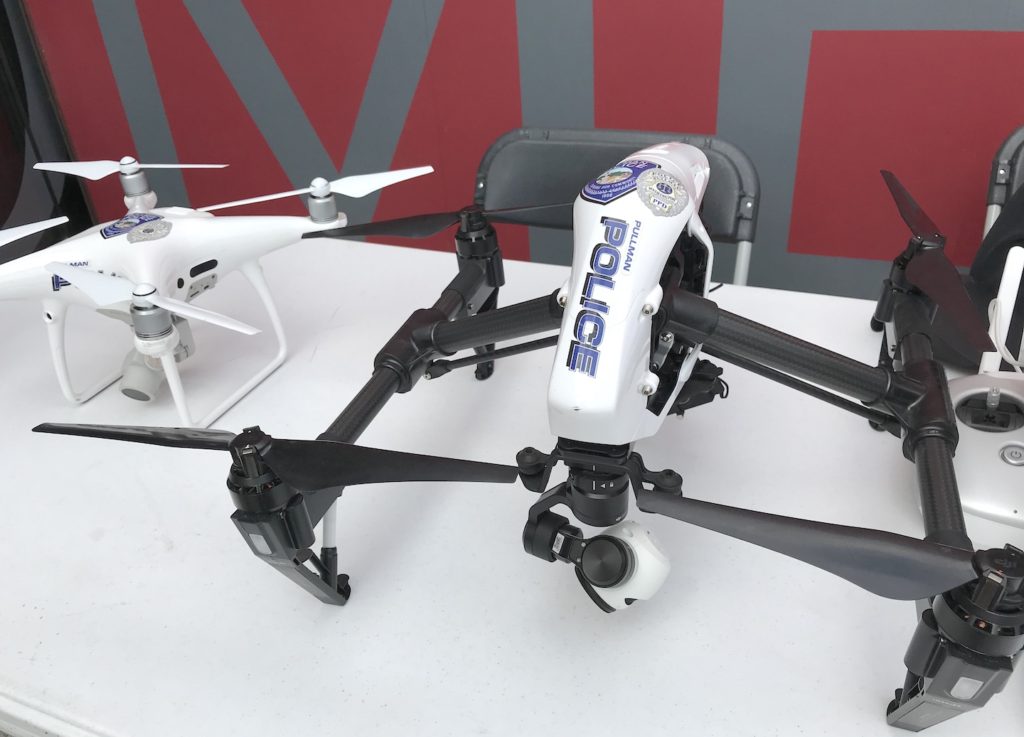Pullman Police Department flight logs show officers have deployed drones about 40 times throughout the past two years, mostly for staff training and community outreach, but officials expect to use them more frequently in the future.
Police Chief Gary Jenkins said the unmanned aerial systems have helped the department educate the public on safe drone flight practices and provided helpful footage of training exercises. Officers have also used them to oversee large public events or disasters like the April flooding (See the video).
“My goal has been to try to deploy them a lot more than we are now,” he said. “I would have guessed we would use it a lot more than we have so far, but part of it is reminding our patrol staff that it’s an available resource.”
The department spent about $9,500 to launch the program in summer of 2017. Jenkins said they now have six police officers and one code enforcement officer licensed to operate the four drones in their fleet. They have certification from the Federal Aviation Administration to fly over five Washington counties and two Idaho counties. They can also fly at night.
“The biggest benefit just has been the public relations part of it,” he said. “It’s been another outlet for us to have some positive relationships with the public.”
The department issued a news release highlighting this week as National Drone Safety Awareness Week.
Pullman police flight logs for July 2017 through May 2019 — obtained by Whitman County Watch via a public records request — indicate 19 of the department’s 42 recorded flights involved community outreach, creating promotional footage or officer training. Those flights included collecting footage of the city’s annual Easter egg hunt, WSU Athletics events and the Lentil Festival parade.
The department could not locate flight logs for January through April of 2018, so the number of total flights may be higher. See a map below of flight locations since May of 2018.
Records show at least 10 flights went up on specific investigations, which included collecting film of multiple arson scenes and a shooting in late 2017. Logs suggest another 10 flights involved surveillance activity for the Quad City Drug Task Force.
Jenkins explained the drug task force surveillance sometimes involved using a drone to capture footage from public areas, such as license plate numbers in a parking lot, to avoid tipping off suspects by having an officer check in person.
“We could get a drone into a spot and zoom in and get that information without being detected,” he said. “There were a number of times when we helped the task force out in collecting that type of information.”
The department’s drone use policy prohibits “random surveillance” and Jenkins said any flight into a private residence or space would still require a search warrant.
“That is the line,” he said. “If it’s a place where we would have to get a warrant to observe it then we would get a warrant.”

The drone policy also prohibits any discriminatory surveillance, personal use or weaponization. Jenkins said one drone has a FLIR infrared camera to view thermal images of hot spots at fire scenes or to search for body heat. The department’s drones do not have any other enhanced viewing capabilities.
The department’s drone program recently received an award for outstanding achievement in local government innovation. The Municipal Research and Services Center, a government consulting nonprofit, also featured the program over the summer. A government service podcast also interviewed Jenkins about the program in May.
A Pullman Police Department video highlights the program’s successes. Watch it here.
Jenkins said he is aware of just one citizen complaint when a drone passed near a sunbathing woman. The internal investigation concluded the test flight had lost connection and was not shooting any footage.
The department has had to replace one drone since the program started after it crashed during a training exercise inside of a building. Jenkins noted flying inside can be a challenge because of a slight delay in the pilot’s viewing goggles.
The American Civil Liberties Union has voiced concerns about the privacy implications of increased police surveillance using drones. They have warned of expanded “wide-area surveillance” of large public areas or pairing aerial footage with facial recognition software to rapidly scan and identify citizens.
The Electronic Frontier Foundation, a digital privacy group, has also shared similar warnings.
The Washington State Patrol now operates a fleet of more than 100 drones across the state. Jenkins said he believes police departments will continue to adopt and utilize the technology in new ways.
The police chief praised an advanced police drone program in Chula Vista, California, where drones get deployed several times a day to provide early air support for officers. The department recently reported drones assisting in at least 130 arrests throughout more than 1,000 flights over the past year.
Jenkins said he sees great potential for more frequent deployments as their pilots learn more about how drones can be used and the department invests in more versatile systems.
“As the technology improves and the prices go down for that technology, we’ll be looking at replacing what we have,” he said. “We definitely want to continue the program and move forward as the technology does.”
Drone flight map
This map shows the locations of drone flights in and around Pullman since 2018 as recorded in flight logs via latitude and longitude. Those records only note a single location and do not reflect flight path or movements between multiple flights.
